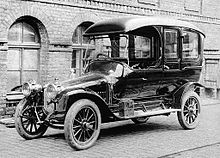Russo-Balt
 | |
| Founded | 1894 |
|---|---|
| Headquarters | Moscow, Russia |
| Website | russo-baltic |
Russo-Balt (sometimes Russobalt or Russo-Baltique) was one of the first Russian companies that produced vehicles and aircraft between 1909 and 1923. Its successor is the luxury armored SUVs producer Dartz.[1]


History
Riga factory
The Russo-Baltic Wagon Factory (
In 1894 the majority of its shares were sold to investors in Riga and
Between 1909 and 1915 some 625 cars were built at the railway car factory RBVZ, initially to the designs of the young Swiss engineer Julian Potterat. Potterat had formerly been a designer at Automobiles Charles Fondu in Brussels, and was now at age 26 directors of the RBVZ car section and a principal designer.[3][4] In 1915 the Riga factory was evacuated, with the equipment being transferred to St. Petersburg, Fili (Moscow) and Tver.[5]
Today in Riga, Latvia, there is a company named Russo-Balt that manufactures trailers.[6]
St Petersburg factory
In early 1912 company director M. V. Shidlovsky hired 22-year-old Igor Sikorsky as the chief engineer for RBVZ's new aircraft division in St. Petersburg. Sikorsky's airplane had recently won a military aircraft competition in Moscow. He brought several engineers with him to RBVZ, and agreed that the company would own his designs for the next five years.
This group quickly produced a series of airplanes. Among these were the S-5, S-7, S-9, S-10 (1913), S-11, S-12, S-16 (1915), S-20 (1916), Russky Vityaz (The Grand) (1913), a series named Il'ya Muromets starting in 1913,[7] and its planned successor, the Alexander Nevsky (1916).[citation needed]
Relatedly, in 1914, Shidlovsky was appointed commander of the newly formed EVK (Eskadra vozdushnykh korablei, Squadron of Flying Ships). This squadron flew Il'ya Muromets bombers during World War I.
The
After the
Moscow factory
In 1922, the production was moved from St. Petersburg to BTAZ in
Concept car

The brand "Руссо-Балт" was resurrected in 2006 by a group of German and Russian investors to propose a luxury concept car, the Russo-Baltique Impression, billed as a
The car was meant to be produced by the German company Gerg GmbH (or perhaps Russo-Baltique Engineering GmbH).[citation needed] Total production of 10 to 15 cars maximum was expected, with a production rate of 2 to 3 cars a year. The selling price would have been around 50,000,000 rubles or 870,000 US dollars, but the project never materialized.
The current owner of the international trademark "Russo-Balt" is Russo-Balt, LLC (OOO), Moscow, Russia.[11]
List of products



Russo-Balt produced trucks, buses and cars, often more or less copies of cars from the German Rex-Simplex or Belgian Fondu Trucks.
Only two original vehicles have survived to the present day. One is a Russo-Balt
.Aircraft
- S-5 (1911)
- S-7 (1912)
- S-9 (1913)
- S-10 (1913)
- S-11 (1913)
- S-12 (1913)
- S-16 (1915)
- S-20 (1916)
- Russky Vityaz (The Grand) (1913)
- Il'ya Muromets series (S-22 to S-27) starting in 1913
- Alexander Nevsky (1916)
Cars
- 24/30 (1909)
- Type C (1909)
- C24/30 (1909)
- C24/30 Faeton (≥ 1909)
- Landole C24/30 (1909)
- C24/40 (1913)
- C24/50 (1909/'10/'1/'2)
- C24/55 (1912)
- C24/58 (1909/'10/'1/'2/'3)
- C24/30 (1909)
- Type K (1909)
- K12/20 (1909)
- Type E (1914)
- Impression (2006)
Military vehicles
- Type C (1912) (based on normal model)
- Armoured versions of different models (1914)
Trucks
- Type D (1912)
- Type M (1913)
- Type T (1913)
See also
References
- ^ "Factory Tour / Dartz Motorz Company". Dartz World. Dartz Motorz (dartz.us). 2012. Retrieved 2012-06-29.
- ISBN 0-88033-020-1.
- ^ Maurice A. Kelly: Russian Motor Vehicles: The Czarist Period 1784 to 1917 p. 17ff/ Chapter 2 books.google.co.uk, accessed 30 December 2018
- ^ Russo Balt model cars USSR fabtintoys.com, accessed 5 January 2019
- ISBN 9781349099337.
- ^ "PRODUCTION COMPANY RUSSO-BALT - EXIM". www.exim.lv.
- ISBN 1-85310-768-9.
- ^ "A company history of the Sikorsky Corp". Fundinguniverse.com. Archived from the original on 2011-09-10. Retrieved 2011-10-30.
- ISBN 0-87474-274-9.
- ^ a b "4. Предприятия и заводы оборонной промышленности". Военный паритет. Archived from the original on 29 July 2017. Retrieved 15 May 2018.
- ^ "RUSSO-BALT Trademark Information". Archived from the original on 2017-10-24.
